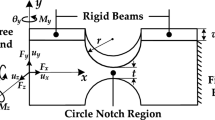Abstract
This paper presents the compliance modeling of circular flexure hinge. The calculation accuracies of several compliance equations are firstly compared with the finite element analysis (FEA) results. Then the influences of the stress concentration on the compliance calculations of the flexure hinge are analyzed systematically. It shows that the stress concentration has great influence on the axial compliance calculation. Utilizing the exponential model, empirical compliance equations of circular flexure hinge are derived, and the influences of the stress concentration on the axial compliance are considered. These empirical compliance equations are verified to be with high calculation accuracy for a wide range of t/R ratios. Finally, the empirical compliance equations are utilized to analyze the compliance and displacement amplification ratio of a bridge-type compliant amplifier. The results are compared with FEA software, and it proves the accuracy and effectiveness of these empirical equations once again. In addition, the modeling method presented in this paper is general and can also be applied to the compliance equations derivation of other types of flexure hinges.
Similar content being viewed by others
References
Liaw, H. C. and Shirinzadeh, B., “Enhanced Adaptive Motion Tracking Control of Piezo-Actuated Flexure-based Four-Bar Mechanisms for Micro/Nano Manipulation,” Sensors and Actuators A: Physical, Vol. 147, No. 1, pp. 254–262, 2008.
Tian, Y., Shirinzadeh, B., Zhang, D., and Zhong, Y., “Three Flexure Hinges for Compliant Mechanism Designs based on Dimensionless Graph Analysis,” Precision Engineering, Vol. 34, No. 1, pp. 92–100, 2010.
Wu, Y. and Zhou, Z., “Design Calculations for Flexure Hinges,” Review of Scientific Instruments, Vol. 73, No. 8, pp. 3101–3106, 2002.
Choi, K.-B. and Lee, J. J., “Passive Compliant Wafer Stage for Single-Step Nano-Imprint Lithography,” Review of Scientific Instruments, Vol. 76, No. 7, Paper No. 075106, 2005.
Salapaka, S., Sebastian, A., Cleveland, J. P., and Salapaka, M. V., “High Bandwidth Nano-Positioner: A Robust Control Approach,” Review of Scientific Instruments, Vol. 73, No. 9, pp. 3232–3241, 2002.
Miller, J. A., Hocken, R., Smith, S. T., and Harb, S., “X-ray Calibrated Tunneling System Utilizing a Dimensionally Stable Nanometer Positioner,” Precision Engineering, Vol. 18, No. 2, pp. 95–102, 1996.
Yao, Q., Dong, J., and Ferreira, P. M., “Design, Analysis, Fabrication and Testing of a Parallel-Kinematic Micropositioning XY Stage,” International Journal of Machine Tools and Manufacture, Vol. 47, No. 6, pp. 946–961, 2007.
Shi, R. C., Dong, W., and Du, Z. J., “Design Methodology and Performance Analysis of Application-Oriented Flexure Hinges,” Review of Scientific Instruments, Vol. 84, No. 7, Paper No. 075005, 2013.
Xu, Q., “Design and Development of a Compact Flexure-based Precision Positioning System with Centimeter Range,” IEEE Transactions on Industrial Electronics, Vol. 61, No. 2, pp. 893–903, 2014.
Kim, D., Kang, D., Shim, J., Song, I., and Gweon, D., “Optimal Design of a Flexure Hinge-based XYZ Atomic Force Microscopy Scanner for Minimizing Abbe Errors,” Review of Scientific Instruments, Vol. 76, No. 7, Paper No. 073706, 2005.
Vallance, R. R., Haghighian, B., and Marsh, E. R., “A Unified Geometric Model for Designing Elastic Pivots,” Precision Engineering, Vol. 32, No. 4, pp. 278–288, 2008.
Paros, J. M., “How to Design Flexure Hinges,” Mach. Des., Vol. 37, No. 27, pp. 151–156, 1965.
Lobontiu, N., “Compliant Mechanisms: Design of Flexure Hinges,” CRC Press, pp. 29–32, 2003.
Tseytlin, Y. M., “Notch Flexure Hinges: An Effective Theory,” Review of Scientific Instruments, Vol. 73, No. 9, pp. 3363–3368, 2002.
Schotborgh, W. O., Kokkeler, F. G., Tragter, H., and van Houten, F. J., “Dimensionless Design Graphs for Flexure Elements and a Comparison between Three Flexure Elements,” Precision Engineering, Vol. 29, No. 1, pp. 41–47, 2005.
Smith, S., Chetwynd, D., and Bowen, D., “Design and Assessment of Monolithic High Precision Translation Mechanisms,” Journal of Physics E: Scientific Instruments, Vol. 20, No. 8, pp. 977–983, 1987.
Yong, Y. K., Lu, T.-F., and Handley, D. C., “Review of Circular Flexure Hinge Design Equations and Derivation of Empirical Formulations,” Precision Engineering, Vol. 32, No. 2, pp. 63–70, 2008.
Yi, B.-J., Chung, G. B., Na, H. Y., Kim, W. K., and Suh, I. H., “Design and Experiment of a 3-DOF Parallel Micromechanism Utilizing Flexure Hinges,” IEEE Transactions on Robotics and Automation, Vol. 19, No. 4, pp. 604–612, 2003.
Li, Y., Huang, J., and Tang, H., “A Compliant Parallel XY Micromotion Stage with Complete Kinematic Decoupling,” IEEE Transactions on Automation Science and Engineering, Vol. 9, No. 3, pp. 538–553, 2012.
Smith, S. T., Badami, V. G., Dale, J. S., and Xu, Y., “Elliptical Flexure Hinges,” Review of Scientific Instruments, Vol. 68, No. 3, pp. 1474–1483, 1997.
Yong, Y. K. and Lu, T.-F., “Comparison of Circular Flexure Hinge Design Equations and the Derivation of Empirical Stiffness Formulations,” Proc. of IEEE/ASME International Conference on Advanced Intelligent Mechatronics, pp. 510–515, 2009.
Lobontiu, N. and Garcia, E., “Analytical Model of Displacement Amplification and Stiffness Optimization for a Class of Flexurebased Compliant Mechanisms,” Computers & Structures, Vol. 81, No. 32, pp. 2797–2810, 2003.
Ma, H.-W., Yao, S.-M., Wang, L.-Q., and Zhong, Z., “Analysis of the Displacement Amplification Ratio of Bridge-Type Flexure Hinge,” Sensors and Actuators A: Physical, Vol. 132, No. 2, pp. 730–736, 2006.
Xu, Q. and Li, Y., “Analytical Modeling, Optimization and Testing of a Compound Bridge-Type Compliant Displacement Amplifier,” Mechanism and Machine Theory, Vol. 46, No. 2, pp. 183–200, 2011.
Lobontiu, N., “Compliance-based Matrix Method for Modeling the Quasi-Static Response of Planar Serial Flexure-Hinge Mechanisms,” Precision Engineering, Vol. 38, No. 3, pp. 639–650, 2014.
Author information
Authors and Affiliations
Corresponding author
Rights and permissions
About this article
Cite this article
Li, TM., Zhang, JL. & Jiang, Y. Derivation of empirical compliance equations for circular flexure hinge considering the effect of stress concentration. Int. J. Precis. Eng. Manuf. 16, 1735–1743 (2015). https://doi.org/10.1007/s12541-015-0228-5
Received:
Revised:
Accepted:
Published:
Issue Date:
DOI: https://doi.org/10.1007/s12541-015-0228-5




